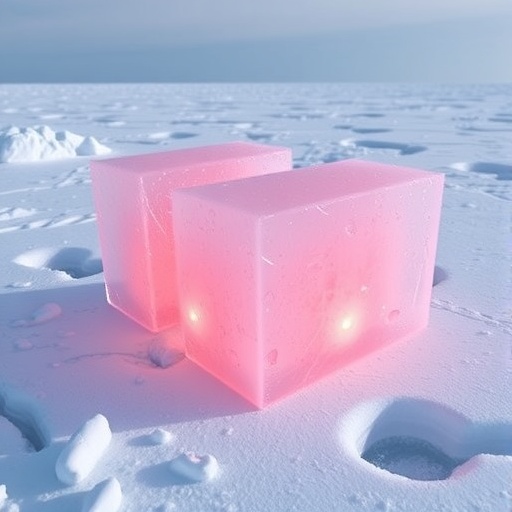In the quest for safer, greener, and more efficient energy storage solutions, a groundbreaking advancement has emerged from the laboratories of the National University of Singapore (NUS). A team led by Professor Praveen Linga from the Department of Chemical and Biomolecular Engineering has pioneered a method to dramatically accelerate the formation of natural gas hydrates using amino acid-modified ice. This innovation promises to revolutionize how natural gas and renewable biomethane are stored and transported, moving beyond the current costly and energy-intensive methods predominantly reliant on high-pressure compression or cryogenic liquefaction.
Natural gas, composed primarily of methane, is a critical component of the global energy mix. Yet, its storage remains a formidable challenge due to methane’s gaseous state under ambient conditions. Conventionally, natural gas is compressed under high pressures or cooled to extremely low temperatures (~-162 °C) to transform it into liquid natural gas (LNG) for storage and transport. Both methods, while effective, consume substantial energy and necessitate expensive infrastructure. An alternative, less-explored approach involves encapsulating methane molecules within water-based cages known as hydrates — ice-like crystalline structures capable of trapping gases. However, the practicality of hydrate-based storage has been hampered by the slow kinetics of hydrate formation, often taking hours to days.
The NUS team’s innovation hinges on the incorporation of specific amino acids into the freezing process of water, producing what they term “amino-acid-modified ice.” Upon exposing this modified ice to methane gas, the resulting hydrate formation occurs within minutes, achieving 90% of theoretical storage capacity rapidly. This is a remarkable improvement compared to the sluggish hydrate formation timeline of conventional methods. The key lies in how amino acids alter the physical and chemical characteristics of the ice surface, thereby facilitating swift methane encapsulation.
At the molecular level, certain hydrophobic amino acids such as tryptophan, methionine, and leucine interact with the ice matrix to create microscopically thin liquid-like layers on the ice surface during methane injection. These layers serve as nucleation sites where hydrate crystallization initiates and accelerates, producing a porous, sponge-like hydrate structure that is both efficient and rapid in gas capture. This behavior contrasts with pure ice’s tendency to develop a dense, impermeable outer shell that obstructs further methane diffusion, significantly decelerating hydrate growth.
Advanced Raman spectroscopy investigations provided conclusive insight into the methane encapsulation mechanism. These studies revealed that methane molecules quickly occupy two distinct cage types within the hydrate lattice with occupancies exceeding 90%, underscoring the dual benefit of the amino acid treatment: not only enhanced formation speed but also efficient molecular packing within the hydrate cages. This spectral evidence substantiates the notion that amino acids serve more than a superficial role, actively influencing the bulk hydrate structure at a molecular scale.
The researchers’ choice and systematic testing of different amino acids revealed a “design rule” dictating functionality based on amino acid properties. Hydrophobic amino acids were effective in promoting rapid hydrate formation, while hydrophilic amino acids such as histidine and arginine failed to produce comparable effects. This clarity in structure-function relationship guides the future rational design of tailored amino-acid-based additives aimed at optimizing solidified natural gas systems.
The implications of this advancement extend beyond mere acceleration of gas capture. This amino acid-based strategy circumvents the environmental risks associated with synthetic surfactants commonly employed to catalyze hydrate formation, which often contribute to aquatic toxicity and persistent foam generation during methane release. The biodegradable and non-foaming nature of amino acid-modified ice offers an environmentally sustainable alternative that reduces operational hazards and costs in large-scale applications.
Reusability and cycle stability are crucial for viable energy storage technologies. Impressively, the NUS team demonstrated that stored methane could be released on demand through gentle heating, after which the amino acid-modified ice could be re-frozen and reused multiple times without loss of efficacy. This ability to cycle the storage medium parallels battery charge-discharge functionality, positioning amino acid-modified hydrates as strong contenders for flexible, closed-loop natural gas storage solutions.
In addition to natural gas, the technique holds exciting promise for renewable biomethane sources, which are increasingly vital in decarbonizing the energy sector. Biomethane production is frequently decentralized and small-scale, often making traditional liquefaction or pressurized storage economically unfeasible. The compact, efficient, and environmentally friendly amino acid approach offers a scalable pathway to harness these emerging renewable gases more effectively.
Looking forward, the team envisions scaling the process from laboratory proof-of-concept to industrial relevance. Efforts include designing reactors that enhance triple-phase gas-liquid-solid contact necessary for efficient hydrate synthesis, exploring hydrate stability improvements via amino acid-engineered composite materials, and broadening the approach to other industrially relevant gases such as carbon dioxide and hydrogen. These applications could catalyze advancements in carbon capture, storage, and clean hydrogen economy technologies.
This newly unveiled approach creatively fuses biology and materials science, leveraging nature’s building blocks — amino acids — to address critical limitations in gas storage technology. The simplicity of mixing water with select amino acids followed by methane exposure stands in sharp contrast to the complexity and costliness of traditional methods. As Professor Linga eloquently summarized, this biodegradable, rapid, and reusable hydrate formation technique not only makes natural gas safer and greener but also adaptive for future energy landscapes.
In sum, the amino-acid-modified ice technology ushers in a promising new era for solidified natural gas storage, characterized by unprecedented formation speed, environmental sustainability, and cycle robustness. As global energy demands evolve, innovations like this that blend scientific insight with practicality could pivotally improve how we capture, store, and utilize methane and beyond — representing a powerful stride toward sustainable energy futures.
Subject of Research: Not applicable
Article Title: Rapid conversion of amino acid modified-ice to methane hydrate for sustainable energy storage
News Publication Date: 30-Sep-2025
Web References: https://rdcu.be/eITrV
References: 10.1038/s41467-025-63699-2
Image Credits: College of Design and Engineering at NUS
Keywords
Energy; Sustainable energy; Environmental sciences; Materials science




